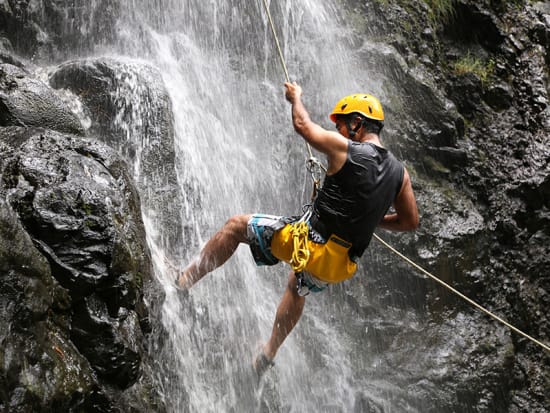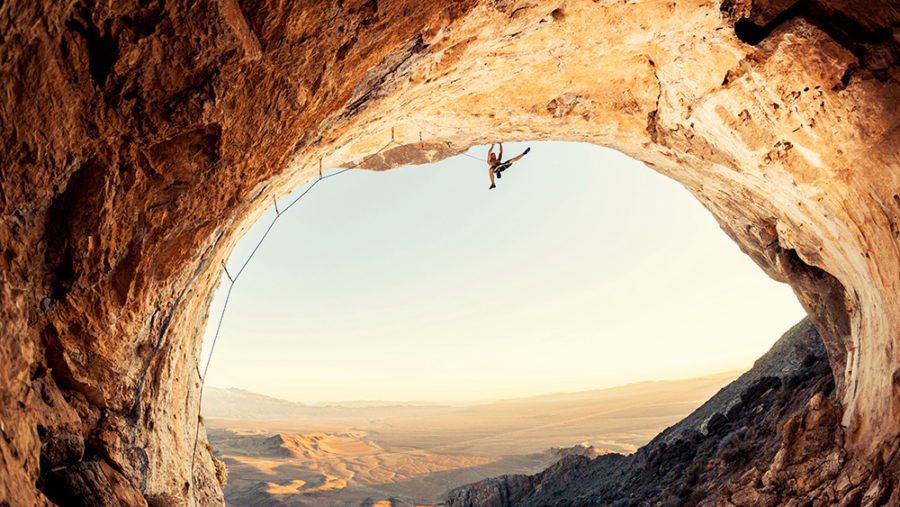Extreme athletes climb mountains, kayak waterfalls and more.
Pushing our mind and body to the breaking point can be thrilling—but at what costs?
The following written content by Paige Reddinger

Lisa Thompson, a 48-year-old mountain climbing enthusiast, is recalling her harrowing trek on the Bottleneck, one of the most perilous passes of her 28,251-foot ascent to the summit of K2 in 2018: “This giant tower of ice is hanging above you, with chunks that periodically fall,” she says, “and you have to climb underneath it for hours.” But the biggest threat lay beneath. “You walk very delicately, right up against it, on a boot path that’s less than the width of your foot. And if you fall there, it’s something like a two-and-a-half-mile drop.”
The Bottleneck comes about 27,000 feet into one of the world’s most treacherous climbs. The inherent difficulty of breathing at that altitude and the unsettling narrowness of the path aside, Thompson says the physical challenge is relatively minor for a seasoned climber. It’s the magnitude of being mere inches from plummeting over the edge and into oblivion that can be mind-blowing. “Getting your body to move quickly and efficiently in a spot like that is 100 percent mental,” she says. “It’s about just telling yourself you can do it.”

The death-defying feats of mountain climbing and other extreme sports tend to garner the lion’s share of attention, whether in highlight reels, Instagram feeds or action movies, but as in Thompson’s case, the mind can be the toughest obstacle to overcome. It takes a rare breed of human to voluntarily cling to the side of a mountain while hurricane-force winds blow and temperatures plunge as low as –25 degrees Fahrenheit. Even an Ironman sounds like a stroll in the park by comparison. But rather than giving prospective athletes pause, that mental challenge is responsible for luring untold numbers of otherwise sane, accomplished professionals to take up pursuits that by definition put them in mortal danger. The profiles of high-octane adrenaline seekers range from perfectionists and people trying to tune out the demands of their successful careers to those searching for a way to overcome grief. Their motivation is also typically a complicated mix of escapism, ego and achievement.
For Type A overachievers, pushing beyond personal limits to notch another victory is an addictive dopamine fix. The neurotransmitter is known for playing a role in how we feel pleasure, but it also helps activate human motivation. “When you get that dopamine hit, it makes you more motivated to reach for bigger goals in the future,” says Judy Ho, a California-based clinical neuropsychologist.
According to a recent poll by Heli, a company that curates adventure-travel excursions, 70 percent of its clients work in finance, tech, entrepreneurship or start-ups, all known for their high-intensity cultures. It’s a number that rings true to Jeremy Lindblad, the global director of business development and innovation at Lindblad Expeditions. “I see this a lot with our clients,” says Lindblad, whose company operates 15 ultra-high-end ships that carry travelers to far-flung destinations such as Antarctica for excursions like a sub-zero kayak ride among the icebergs, or Alaska to go rafting on the Chilkat River—trips that can cost $38,000 per person for two weeks. “They feel like, ‘I’ve won at a lot of things, and I want to do something that is challenging and introspective, and see where my body can take me.’ They do one thing, and then they definitely have to do the next and the next. It’s an addiction, right? Instead of buying companies, they’re now summiting mountains.” Read more from Robb Report.





